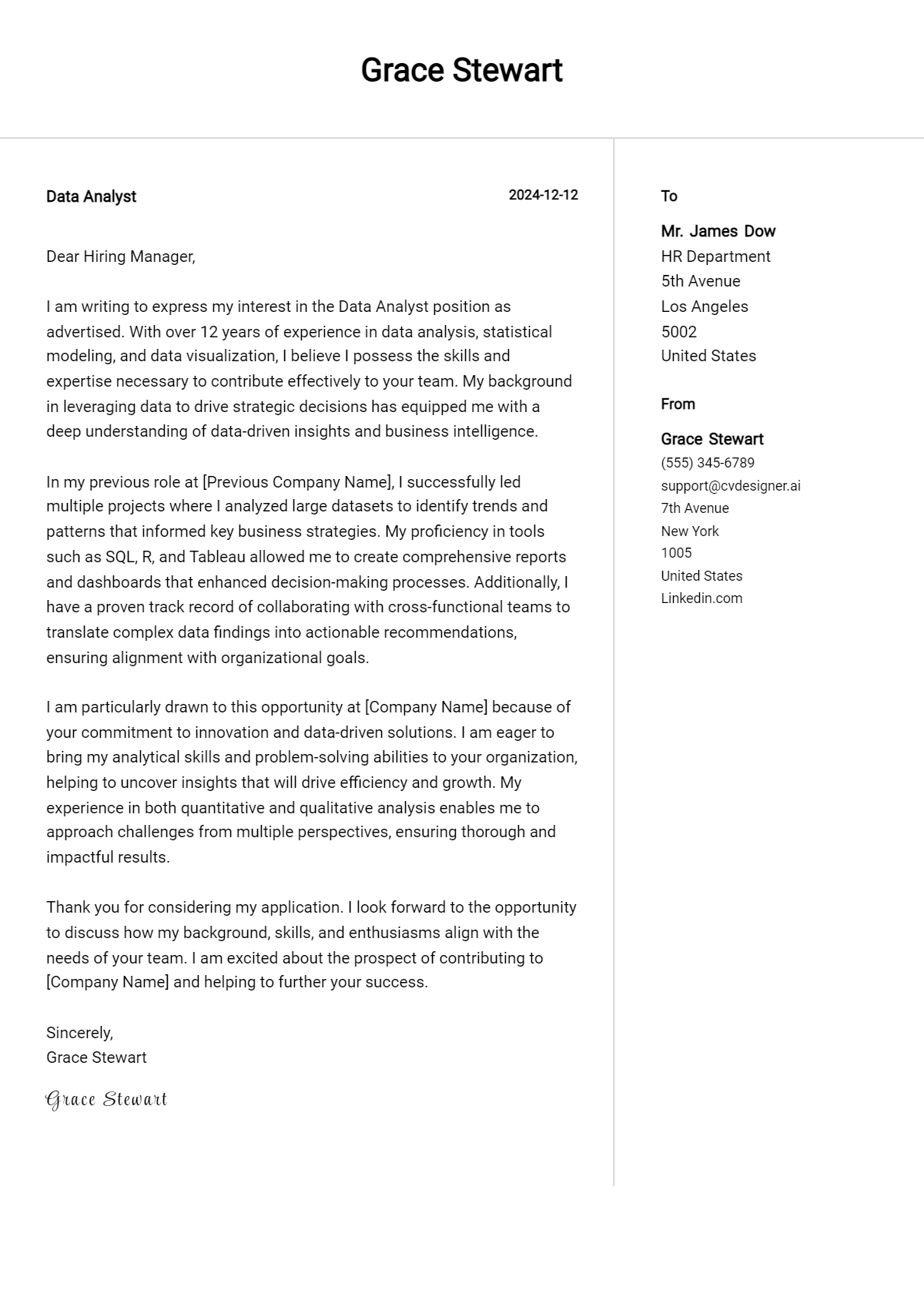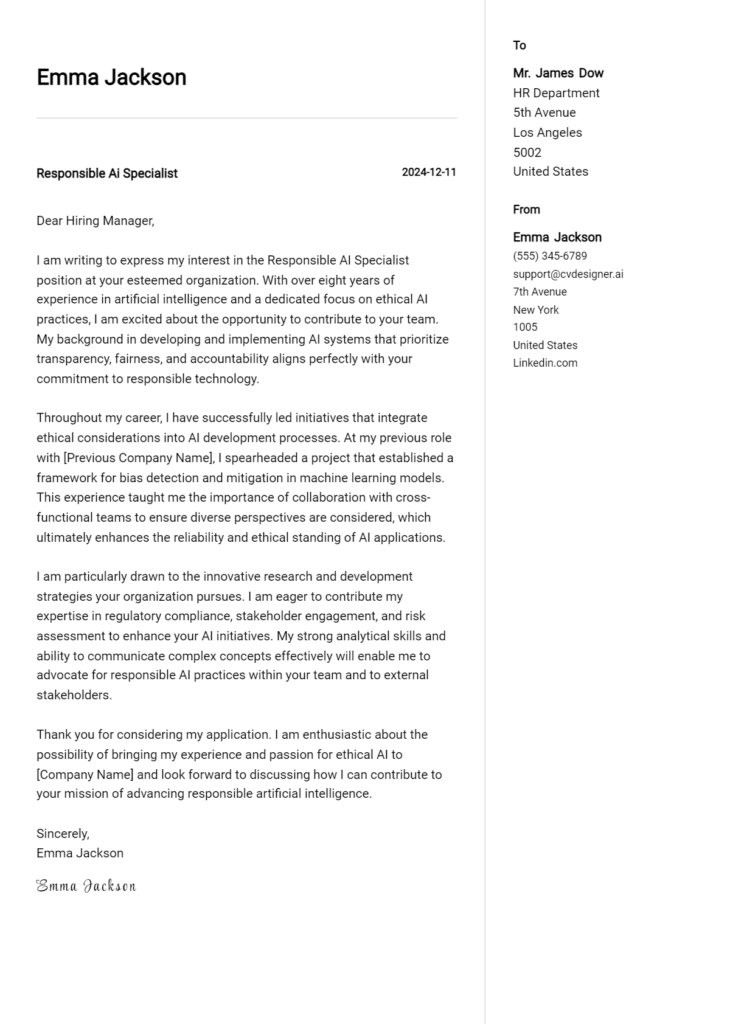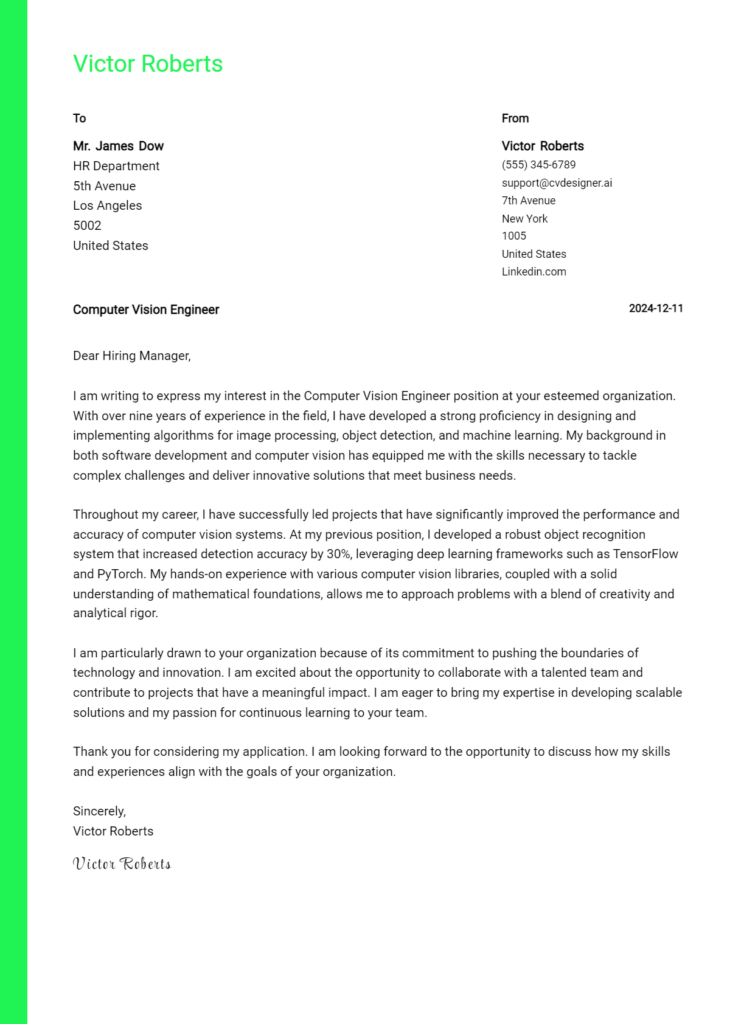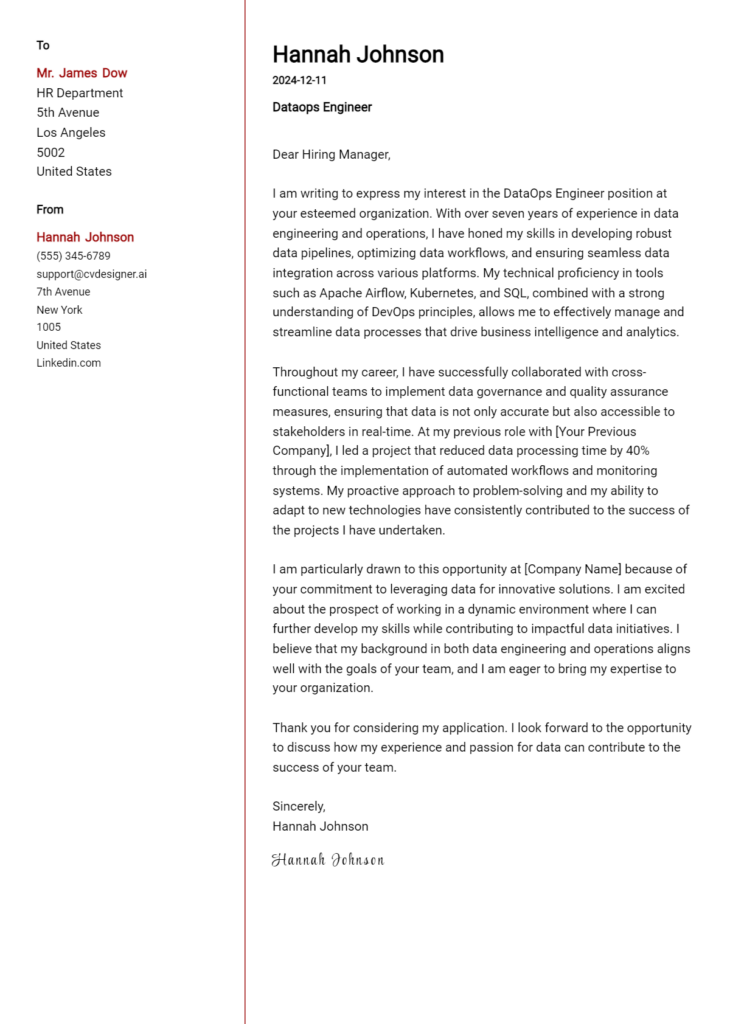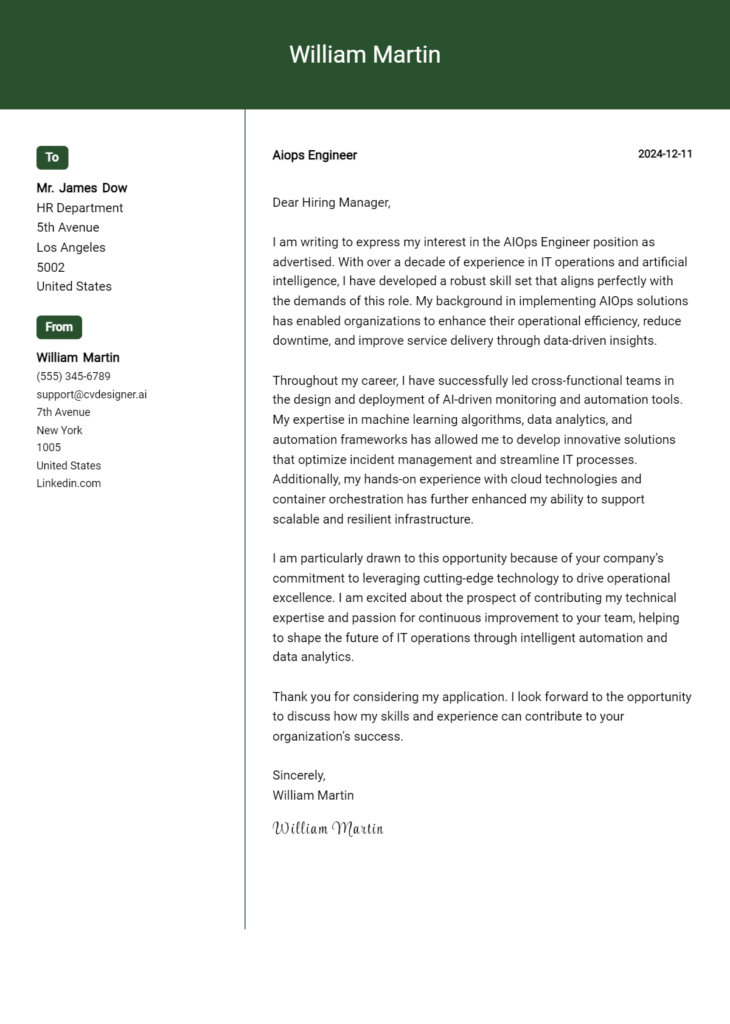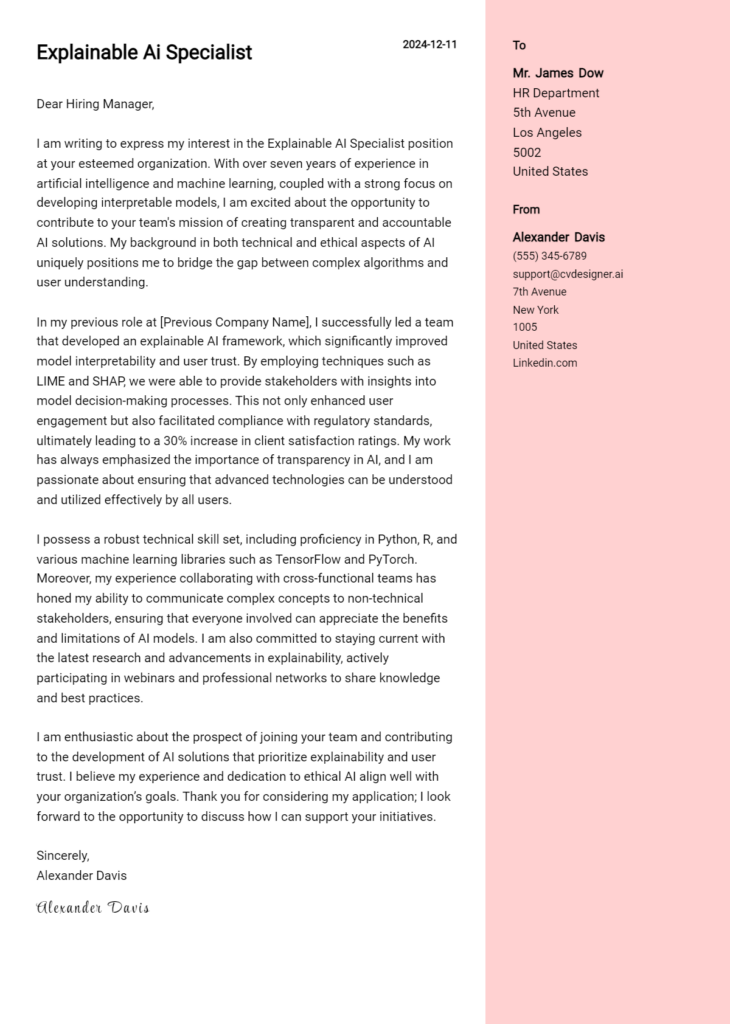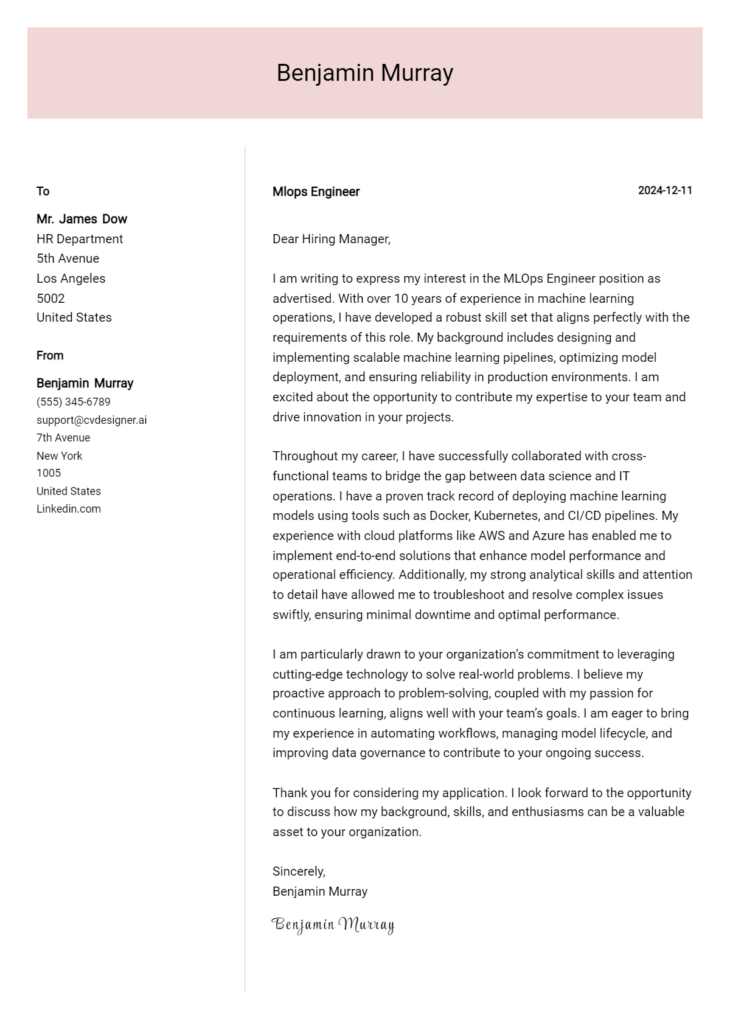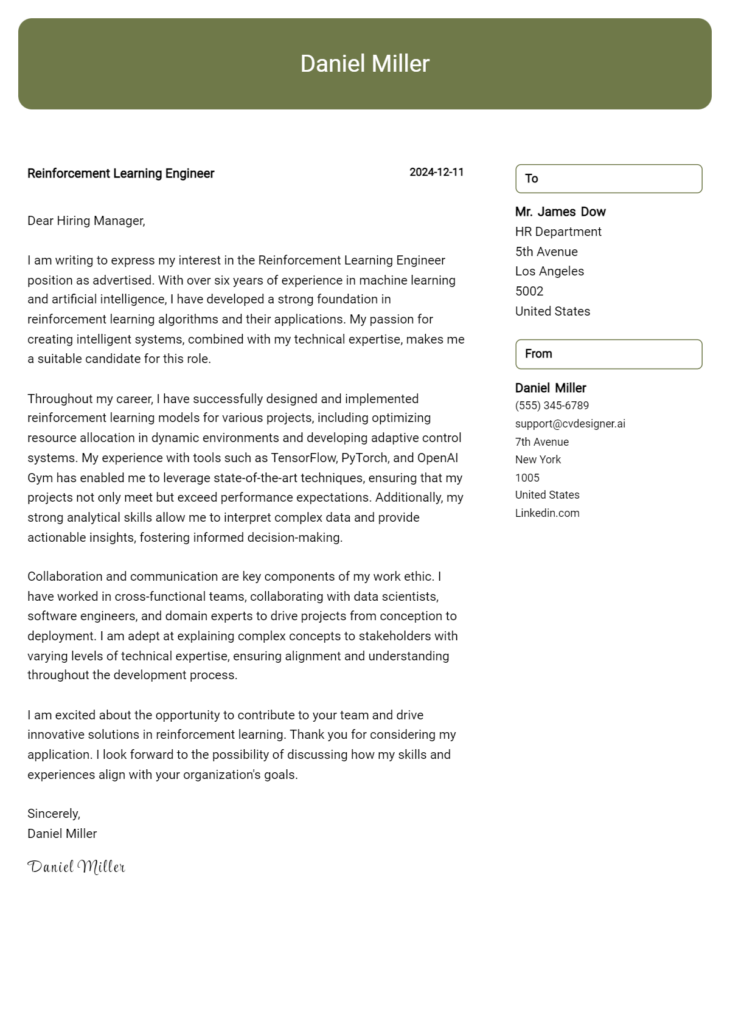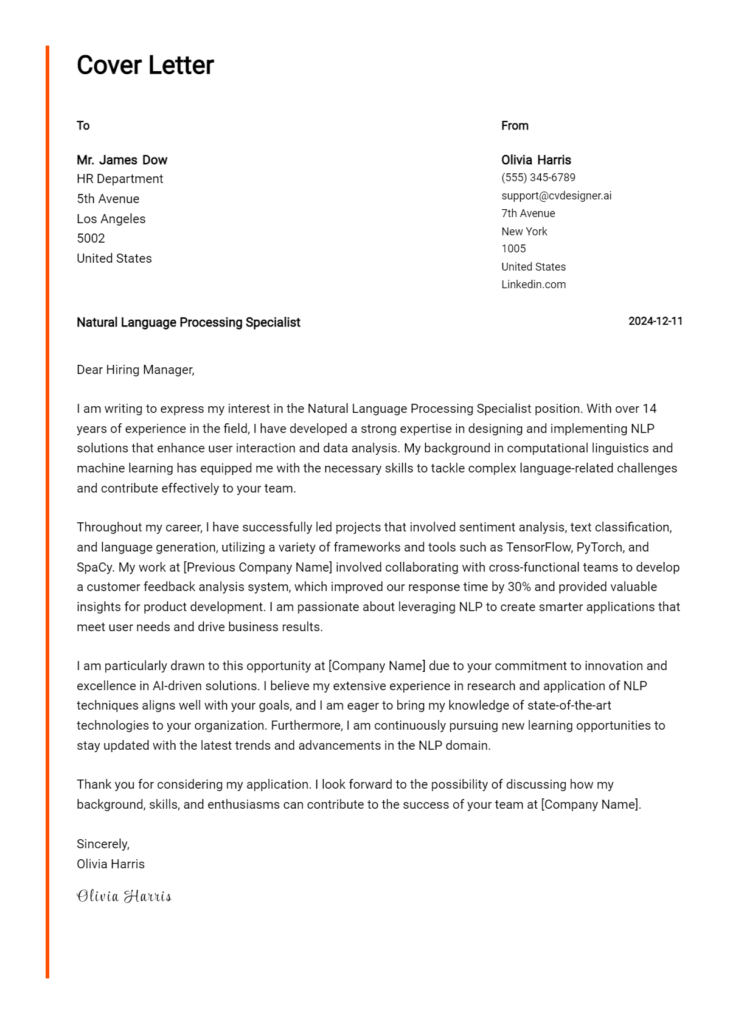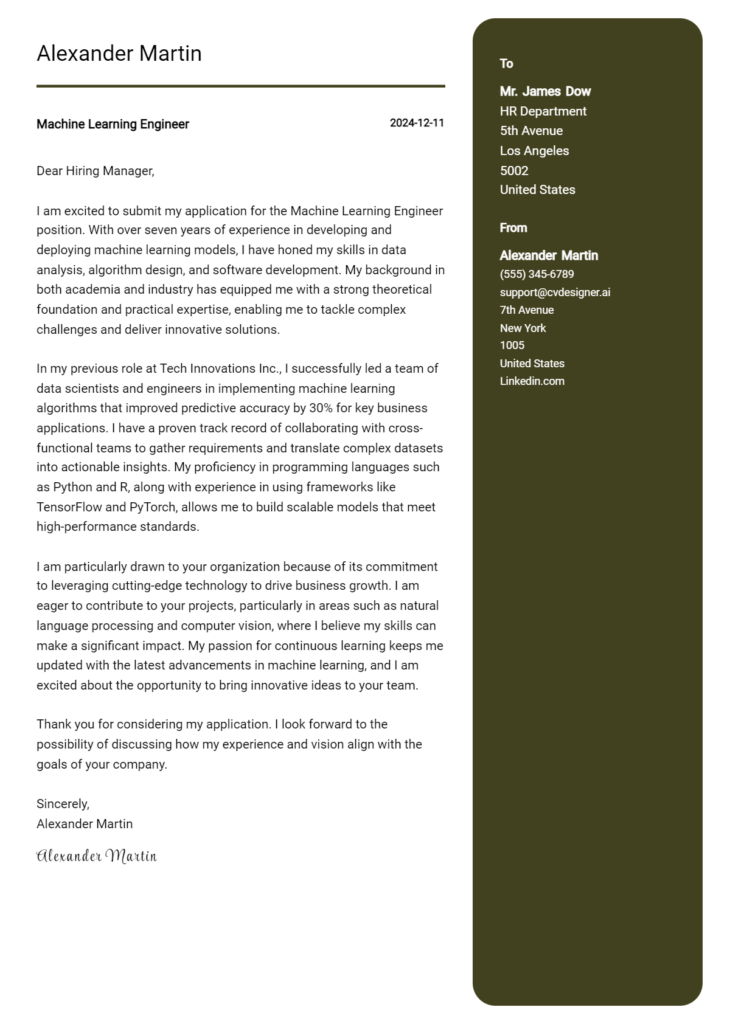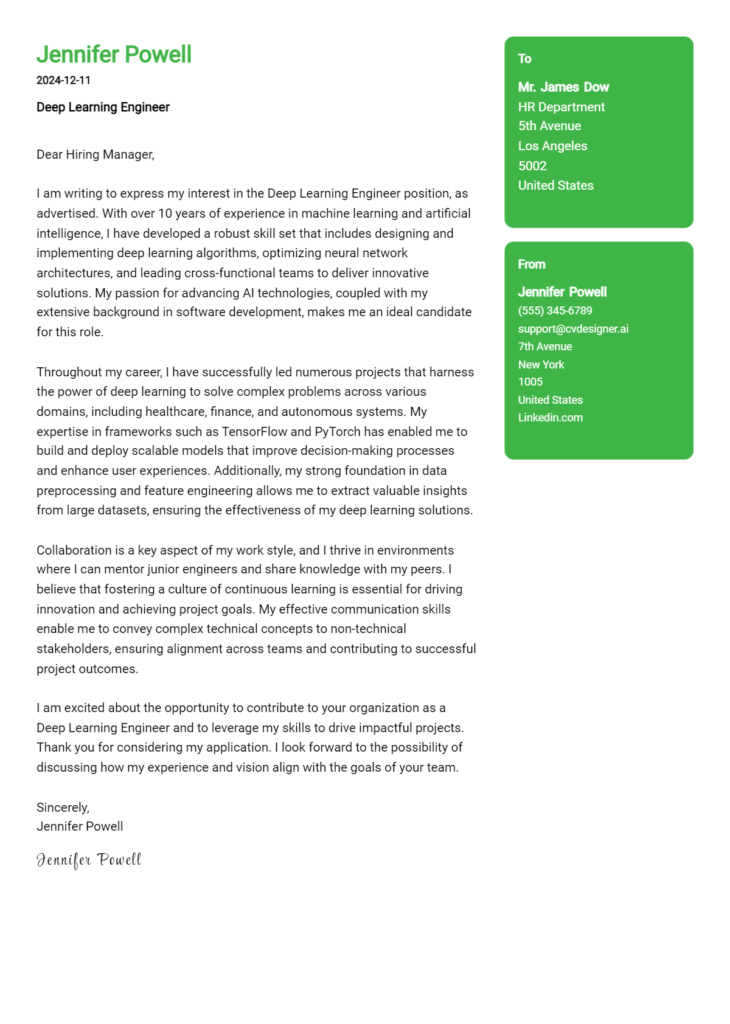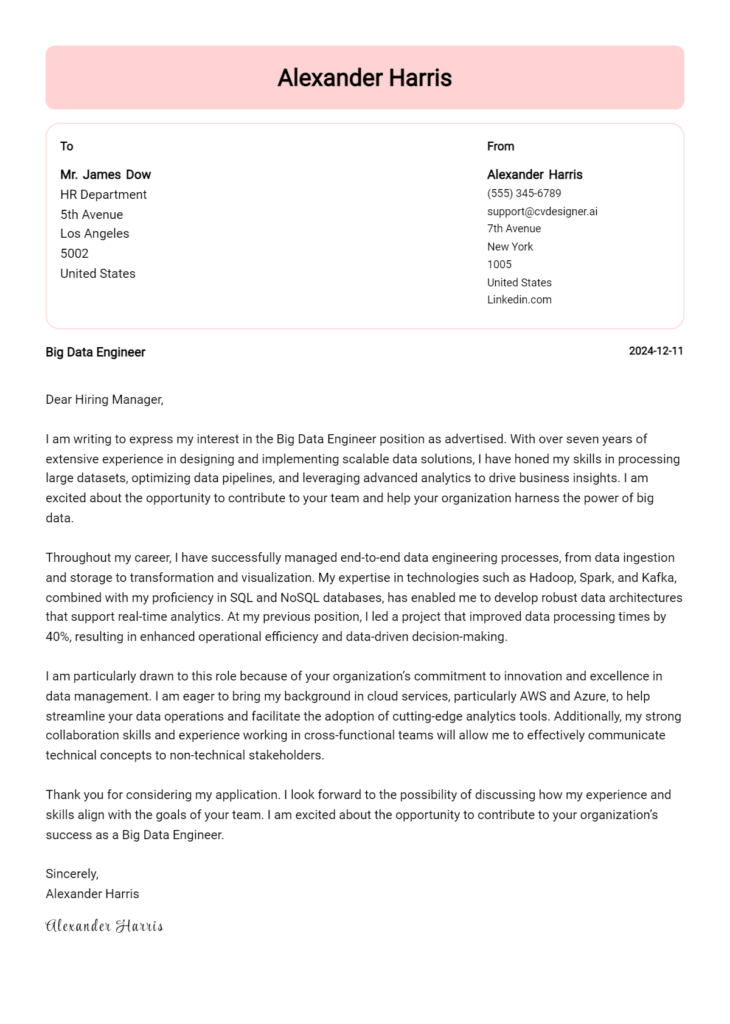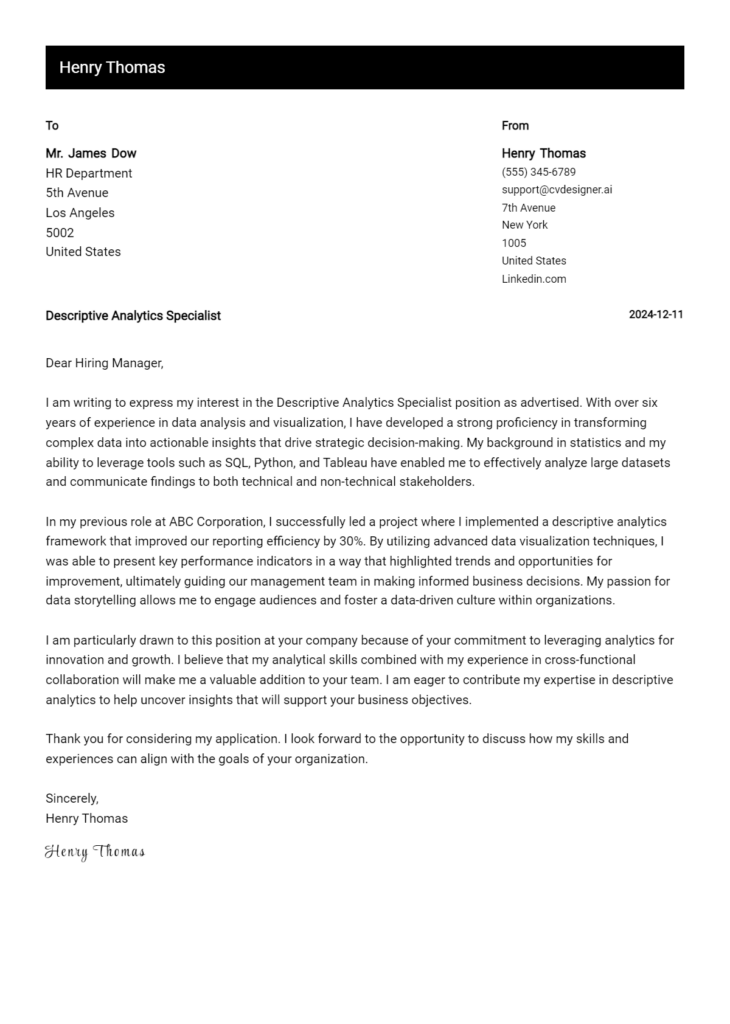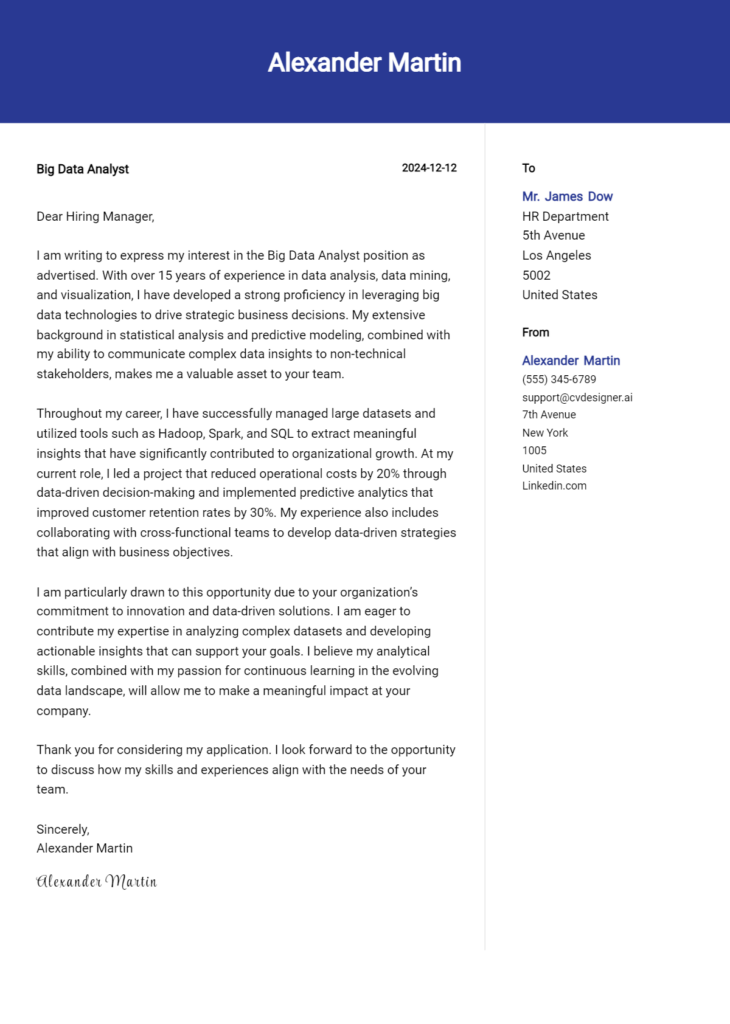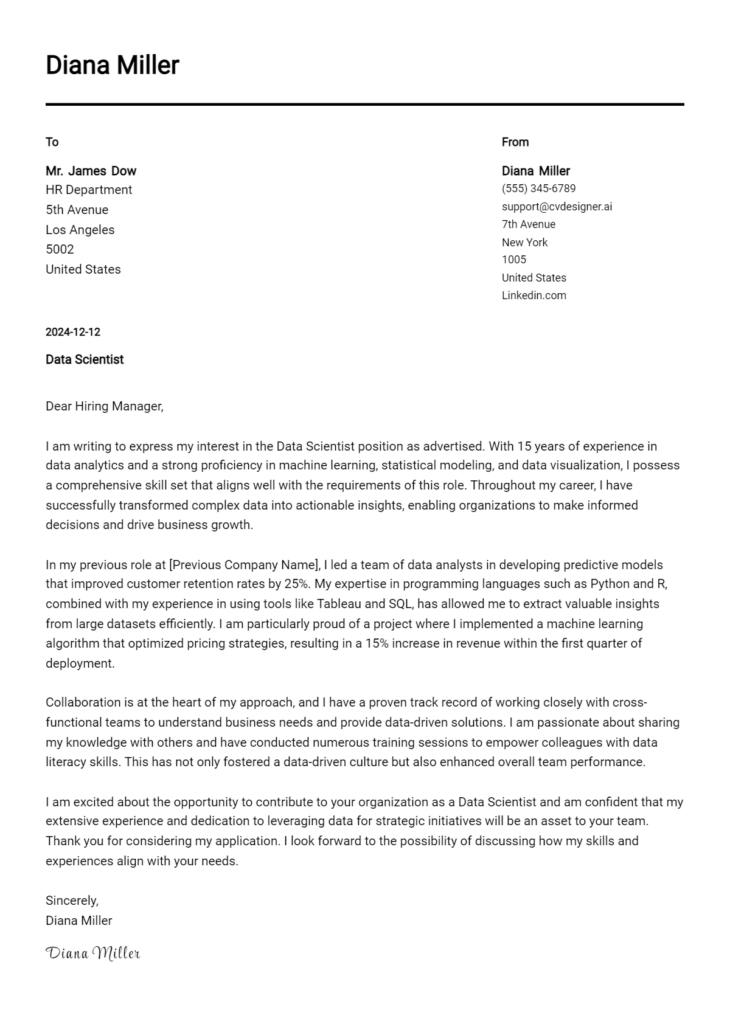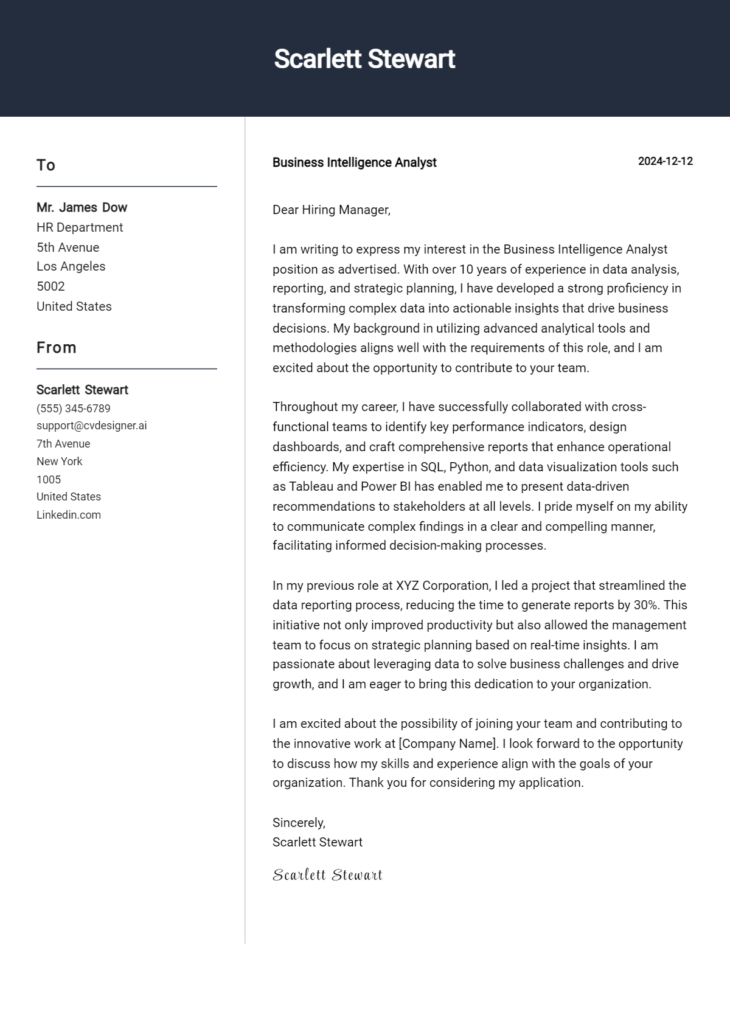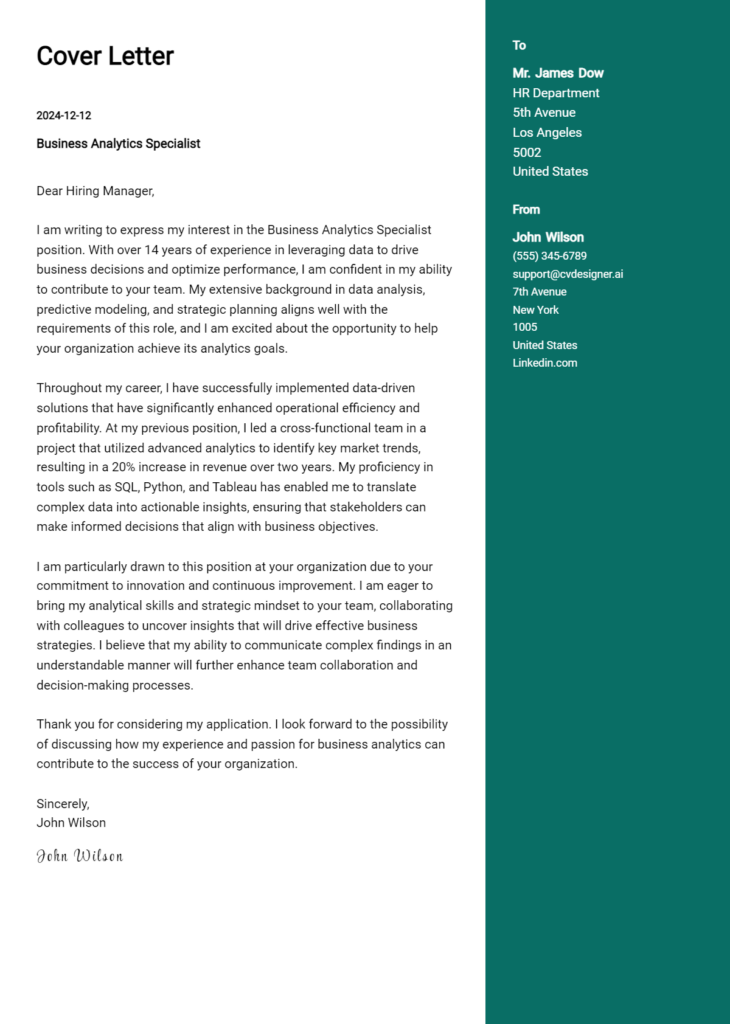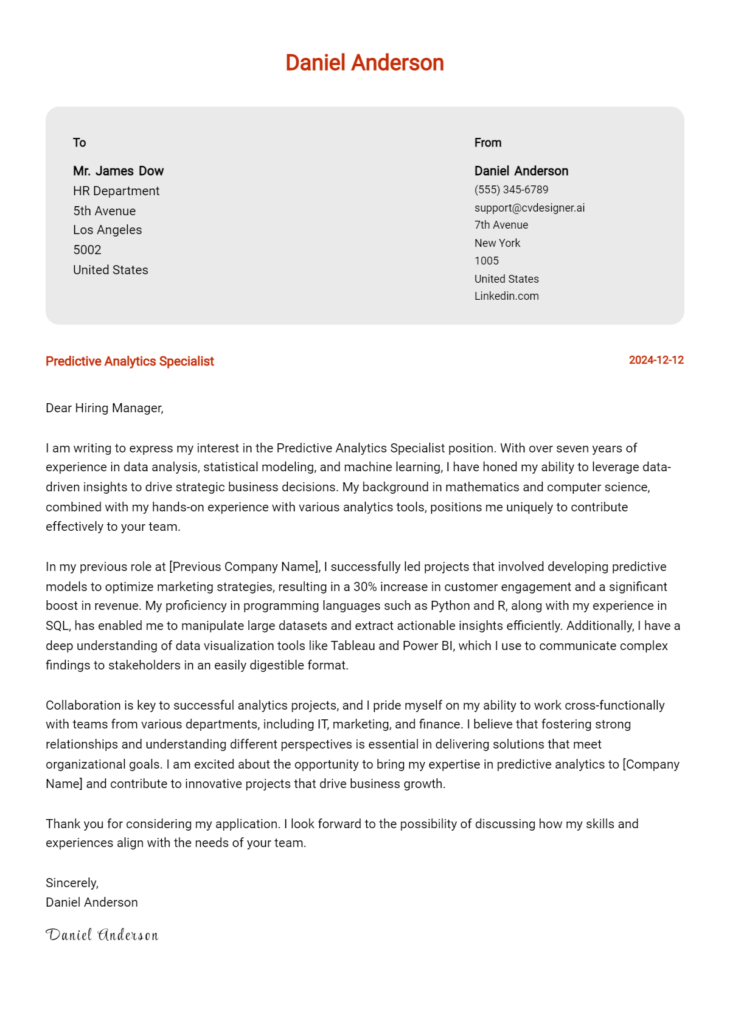Data Analyst Cover Letter Examples
Explore additional Data Analyst cover letter samples and guides and see what works for your level of experience or role.
How to Format a Data Analyst Cover Letter?
Crafting a compelling cover letter is essential for a Data Analyst, as it serves as a first impression of your analytical abilities and attention to detail. A well-formatted cover letter not only presents your qualifications but also demonstrates your organizational skills and clarity of thought—qualities that are highly valued in data analysis. The way you structure your cover letter can effectively capture the hiring manager's attention and convey professionalism, setting you apart from other candidates.
In this guide, we will outline how to format your cover letter to make a strong impact. We will focus on the essential components, including:
- Cover Letter Header
- Cover Letter Greeting
- Cover Letter Introduction
- Cover Letter Body
- Cover Letter Closing
Each section plays a vital role in showcasing your capabilities and dedication to the field. Let's delve into the specifics of each part to ensure your Data Analyst cover letter stands out.
Importance of the Cover Letter Header for a Data Analyst
The cover letter header is a crucial element of any job application, particularly for a Data Analyst role. It sets the tone for your document and provides essential information at a glance. A well-structured header should include your contact information, the date, and the recipient's details. This ensures clarity and professionalism, making it easy for hiring managers to reach you and understand the context of your application. A strong header not only enhances your credibility but also reflects your attention to detail—a key attribute in data analysis.
Strong Example
John Doe 123 Data Lane Analytics City, AC 12345 john.doe@email.com (123) 456-7890 March 15, 2023 Jane Smith Hiring Manager Data Solutions Inc. 456 Insight Road Data Town, DT 67890
Weak Example
John Doe email@email.com March 15 To Whom It May Concern
In these examples, the strong header presents a clear and complete set of information, while the weak header lacks clarity and professionalism, which could hinder the applicant's chances of making a positive impression.
The Importance of a Strong Cover Letter Greeting for a Data Analyst Application
The greeting of your cover letter is crucial as it sets the tone for the entire document. A well-crafted greeting not only demonstrates your professionalism but also reflects your attention to detail and willingness to personalize your application. By addressing the hiring manager directly, you create an immediate connection and show your genuine interest in the position. To make a lasting impression, avoid generic greetings such as "To Whom It May Concern." Instead, take the time to research the recipient's name, which can often be found on the company website or through LinkedIn. This small effort can significantly enhance the impact of your cover letter.
Strong Greeting Example
Dear Ms. Jane Smith,
Weak Greeting Example
To Whom It May Concern,
Cover Letter Introduction for Data Analyst
A well-crafted cover letter introduction is crucial for a Data Analyst position, as it serves as the first impression for the hiring manager. This opening paragraph should not only capture attention but also convey genuine interest in the role while highlighting the candidate’s most relevant skills or achievements. A strong introduction sets the tone for the rest of the cover letter, making it essential to strike the right balance between professionalism and enthusiasm. Below are examples of both strong and weak introductions for a Data Analyst cover letter to illustrate how to effectively communicate your value.
Strong Example
Dear [Hiring Manager's Name], With a passion for transforming data into actionable insights, I am excited to apply for the Data Analyst position at [Company Name]. My background in statistical analysis, combined with over three years of experience using Python and SQL to drive business decision-making, has equipped me with the tools to contribute effectively to your team. I am particularly drawn to [Company Name]'s commitment to data-driven strategies and am eager to leverage my skills to support your objectives.
Weak Example
Dear [Hiring Manager's Name], I am writing to apply for the Data Analyst job. I have some experience with data, and I think I could do a good job. I hope you consider my application.
Purpose of the Cover Letter Body for a Data Analyst
The cover letter body for a Data Analyst serves as a vital opportunity for candidates to articulate their skills, experiences, and the unique value they bring to the prospective employer. It allows them to highlight specific projects and accomplishments that demonstrate their analytical abilities, technical expertise, and problem-solving skills. By providing relevant examples, candidates can illustrate how their previous work has led to actionable insights, improved processes, or significant contributions to business outcomes. This section should effectively connect the candidate's background to the needs of the company, showing how they can contribute to the organization’s goals.
Strong Example
In my previous role at XYZ Corporation, I successfully led a project that analyzed customer behavior patterns using SQL and Python, which resulted in a 15% increase in customer retention rates. By developing a predictive model that identified at-risk customers, I collaborated with the marketing team to implement targeted campaigns that directly addressed their needs. Additionally, my experience in data visualization using Tableau allowed me to present complex data in an easily digestible format, enabling executive leadership to make informed decisions quickly. I am eager to bring my analytical skills and passion for data-driven decision-making to your team at ABC Company.
Weak Example
I have worked with data before and I think I would be a good fit for this job. I have used Excel and sometimes do some analysis. I would enjoy working at your company because I want to learn more about data. I believe I can help with your data needs, though I don't have specific examples right now.
The Importance of a Strong Cover Letter Closing for a Data Analyst
The closing paragraph of a cover letter is crucial for a Data Analyst as it serves to summarize qualifications, reiterate enthusiasm for the position, and encourage the hiring manager to take the next steps, such as reviewing the resume or scheduling an interview. A well-crafted closing can leave a lasting impression, while a weak one may diminish the impact of the entire letter.
Strong Example
Thank you for considering my application for the Data Analyst position at XYZ Company. I am excited about the opportunity to leverage my analytical skills and extensive experience in data visualization to contribute to your team. I am confident that my background in statistical analysis and my passion for deriving actionable insights from complex datasets align well with the goals of your organization. I look forward to the possibility of discussing my application further and hope to schedule an interview at your earliest convenience.
Weak Example
So, uh, I hope you think about my application for the Data Analyst role. I guess I have some experience that might be useful. If you want to talk, that would be cool. Thanks.
These tips will guide candidates in crafting an effective cover letter for a Data Analyst position. An impactful cover letter should not only highlight your technical skills but also demonstrate your problem-solving abilities, knowledge of the Software Development Life Cycle (SDLC), teamwork experience, and a commitment to continuous learning. By emphasizing these attributes, you can make a strong impression on prospective employers.
Tips for Crafting an Effective Data Analyst Cover Letter
Highlight Technical Skills
Clearly outline your technical skills relevant to data analysis, such as proficiency in SQL, Python, R, or data visualization tools like Tableau and Power BI. Use specific examples to illustrate how you've applied these skills in past projects. This not only showcases your abilities but also aligns them with the job requirements.Showcase Problem-Solving Abilities
Describe instances where you've successfully tackled complex data-related challenges. Whether it was optimizing a reporting process or deriving insights from a large dataset, narrating your problem-solving approach can demonstrate your analytical mindset and creativity in finding solutions.Demonstrate SDLC Knowledge
If you've been involved in projects that follow the Software Development Life Cycle, mention your role in those processes. Discussing your familiarity with stages such as requirements gathering, testing, and deployment will reflect your comprehensive understanding of data projects and your ability to work within structured frameworks.Emphasize Teamwork and Collaboration
Data analysts often work in teams with various stakeholders. Share examples of how you collaborated with cross-functional teams, such as developers, marketers, or product managers, to drive data-driven decision-making. This will highlight your interpersonal skills and ability to communicate technical findings effectively.Express a Passion for Continuous Learning
The field of data analysis is constantly evolving, so it's essential to convey your enthusiasm for continuous learning. Mention any recent courses, certifications, or workshops you've attended that relate to data analysis. This shows prospective employers that you are proactive in keeping your skills current and are dedicated to professional growth.
By integrating these elements into your cover letter, you can create a compelling narrative that resonates with hiring managers. For additional assistance, consider using cover letter templates or a cover letter builder to streamline the writing process.
Common Mistakes to Avoid in a Data Analyst Cover Letter
Crafting a compelling cover letter is essential for making a strong impression as a Data Analyst. Avoiding common pitfalls can significantly enhance your chances of standing out to potential employers. Here are some frequent mistakes to watch out for:
Generic Content: Failing to tailor your cover letter to the specific job can make it seem impersonal. Always customize your letter to fit the position you’re applying for.
Lack of Specific Examples: Not providing concrete examples of your skills or accomplishments can weaken your application. Be sure to include data-driven results that demonstrate your analytical skills.
Overly Technical Language: Using jargon or complex terminology may alienate non-technical hiring managers. Aim for clarity and simplicity while still showcasing your expertise.
Neglecting Formatting: A poorly formatted cover letter can be off-putting. Familiarize yourself with proper cover letter format to ensure your document is professional and easy to read.
Ignoring the Job Description: Not addressing the qualifications or responsibilities listed in the job description can suggest a lack of interest. Reference specific points in the job ad to align your skills with their needs.
Typos and Errors: Spelling mistakes or grammatical errors can undermine your credibility. Always proofread your letter or ask someone else to review it before submission.
Failing to Show Enthusiasm: A lack of enthusiasm can make your application seem lackluster. Convey genuine interest in the position and the company to make a more impactful connection.
For inspiration, check out these cover letter examples to see how to effectively convey your qualifications while avoiding these common mistakes.
Cover Letter FAQs for Data Analyst
What should I include in my cover letter as a Data Analyst?
In your cover letter, start with a strong introduction that captures attention. Clearly state the position you’re applying for and express your enthusiasm for the role. Highlight relevant skills such as data visualization, statistical analysis, and proficiency in tools like SQL, Python, or Excel. Provide specific examples of past projects where you successfully analyzed data to drive business decisions, showcasing your analytical thinking and problem-solving abilities. Also, mention any relevant certifications or coursework that reinforce your suitability for the role. End with a summary of why you’re a great fit and express your eagerness to discuss your application further.
How can I tailor my cover letter for a specific Data Analyst job?
To tailor your cover letter, carefully read the job description and identify key skills and qualifications sought by the employer. Incorporate these keywords and phrases into your letter to demonstrate alignment with the role. Customize your examples to reflect experiences that are directly relevant to the specific responsibilities mentioned in the job posting. For instance, if the job emphasizes experience with data visualization tools, provide an example of how you utilized such tools in previous projects. Personalizing your cover letter not only shows genuine interest but also enhances your chances of standing out among other applicants.
Should I mention my technical skills in my cover letter?
Absolutely! As a Data Analyst, your technical skills are crucial to your role, and mentioning them in your cover letter is essential. Highlight your proficiency in programming languages like SQL, Python, or R, as well as your experience with data visualization tools like Tableau or Power BI. Explain how you have used these skills to solve real-world problems, such as improving data accuracy or generating actionable insights that influenced business strategy. Providing quantifiable achievements, like “increased reporting efficiency by 30%,” can significantly strengthen your case. Remember to balance technical details with your analytical mindset and problem-solving approach.
How long should my cover letter be for a Data Analyst position?
Your cover letter should ideally be one page long, consisting of three to four paragraphs. Aim for a concise, focused approach that effectively communicates your qualifications without overwhelming the reader. Use clear and straightforward language, ensuring that each sentence adds value to your application. Typically, a well-structured cover letter should include an introduction, a paragraph detailing your relevant experience and skills, another highlighting your accomplishments, and a closing paragraph expressing your interest in the position and inviting further discussion. Keeping it succinct ensures that hiring managers can easily digest your information while maintaining their interest.
Build your Cover Letter in minutes
Use an AI-powered cover letter builder and have your letter done in 5 minutes. Just select your template and our software will guide you through the process.

